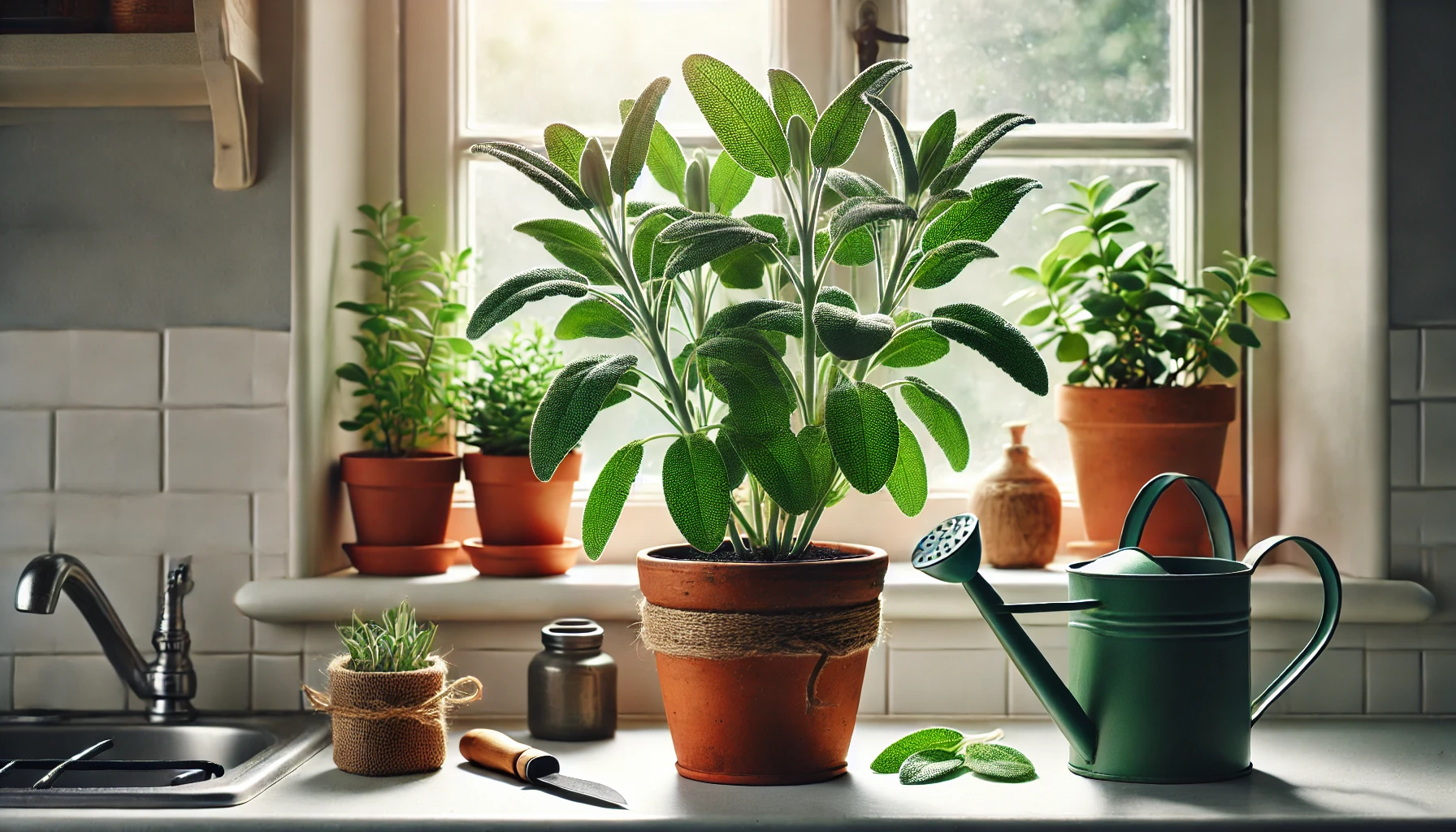Sage is a flavorful, aromatic herb that is easy to grow indoors and offers culinary and medicinal benefits. Whether you’re using it for cooking, tea, or air purification, growing sage at home ensures a fresh supply year-round. With the right conditions, sage thrives indoors with minimal maintenance. This guide will help you successfully grow and care for sage indoors.
1. Why Grow Sage Indoors?
Growing sage indoors has several advantages:
- Fresh leaves year-round – No need to buy dried sage.
- Space-saving – Grows well in small pots, making it ideal for apartments.
- Easy maintenance – Drought-tolerant and requires minimal care.
- Air purification – Like other herbs, sage helps clean indoor air.
2. Choosing the Right Variety of Sage
There are many types of sage, but some are better suited for indoor growing:
- Common Sage (Salvia officinalis) – The classic variety, great for cooking.
- Garden Sage (Salvia elegans) – Slightly sweeter, often used for herbal teas.
- Purple Sage (Salvia officinalis ‘Purpurascens’) – A visually appealing variety with deep purple leaves.
- Tricolor Sage (Salvia officinalis ‘Tricolor’) – A decorative variety with green, white, and purple leaves.
For indoor cultivation, Common Sage is the best choice due to its compact size and culinary versatility.
3. Selecting the Right Pot and Soil
Choosing the Best Pot
- Use a 6–8 inch container with drainage holes to prevent water buildup.
- Terracotta or ceramic pots are ideal as they help absorb excess moisture.
The Best Soil for Sage
- Use a light, well-draining potting mix, preferably formulated for herbs or succulents.
- Add perlite or sand to improve aeration and drainage.
- Avoid compacted or water-retentive soil.
4. Providing the Right Light Conditions
Sage is a sun-loving herb and requires plenty of light to grow indoors.
- Place the pot in a south- or west-facing window where it receives 6–8 hours of direct sunlight daily.
- If natural light is insufficient, supplement with a full-spectrum LED grow light for at least 10–12 hours per day.
- Rotate the pot occasionally to ensure even light exposure.
5. Watering and Humidity Needs
Sage is a drought-tolerant herb and prefers slightly dry conditions.
- Water only when the top inch of soil is dry. Stick your finger in the soil to check before watering.
- Avoid overwatering, as sage is prone to root rot in soggy soil.
- Water at the base of the plant rather than on the leaves to prevent fungal issues.
- Sage prefers low humidity—avoid misting the leaves.
6. Temperature and Air Circulation
Sage is a hardy herb but thrives best in controlled indoor conditions.
- Keep the temperature between 65–75°F (18–24°C) during the day.
- At night, sage can tolerate temperatures as low as 55°F (13°C).
- Avoid placing the plant near cold drafts, heaters, or air conditioning vents.
- Ensure good air circulation to prevent mold growth.
7. Fertilizing for Healthy Growth
Sage is not a heavy feeder but benefits from occasional fertilization.
- Use a balanced liquid fertilizer diluted to half strength once every 4–6 weeks.
- Organic options like compost tea or fish emulsion work well for natural feeding.
- Avoid over-fertilizing, as too much nitrogen can reduce the herb’s flavor intensity.
8. Pruning and Harvesting Sage
Regular pruning encourages bushy growth and prevents the plant from becoming woody.
How to Prune Sage for Best Growth
- Once the plant reaches 4–6 inches tall, start trimming the top leaves.
- Always cut just above a leaf node (where leaves grow from the stem) to promote branching.
- Remove old, woody stems to encourage fresh growth.
Harvesting Sage for Cooking
- Harvest leaves by snipping stems with scissors rather than plucking individual leaves.
- For the best flavor, harvest sage in the morning when the oils are most concentrated.
- Store fresh sage in the fridge, or dry it for later use by hanging small bunches upside down in a dry, well-ventilated area.
9. Common Problems and How to Fix Them
1. Yellowing Leaves
Cause: Overwatering or poor drainage.
Solution: Let the soil dry before watering again and ensure proper drainage.
2. Leggy Growth
Cause: Not enough sunlight.
Solution: Move to a sunnier location or supplement with a grow light.
3. Moldy Soil or Leaves
Cause: Poor air circulation or overwatering.
Solution: Improve airflow and avoid watering leaves directly.
4. No Flavor in Leaves
Cause: Too much fertilizer or lack of pruning.
Solution: Reduce feeding and trim frequently to stimulate stronger growth.
10. Propagating Sage for More Plants
Sage can be easily propagated through cuttings, allowing you to grow more plants without buying new ones.
How to Propagate Sage from Cuttings
- Cut a 4–6 inch stem just below a leaf node.
- Remove the lower leaves and place the cutting in a jar of water.
- Change the water every 2–3 days and keep it in bright, indirect light.
- After 2–3 weeks, roots should appear. Transfer the cutting to a pot with well-draining soil.
11. Companion Plants for Sage
If growing multiple herbs indoors, sage pairs well with:
- Rosemary – Similar water and light needs.
- Thyme – Thrives in the same dry conditions.
- Oregano – Complements sage in both growth and cooking.
Avoid planting sage with moisture-loving herbs like basil or parsley, as they have different watering needs.
12. Using Fresh and Dried Sage
Sage is known for its culinary and medicinal properties:
- Cooking – Enhances flavor in meats, soups, and roasted vegetables.
- Herbal Tea – Brew fresh or dried leaves for a calming tea.
- Aromatherapy – Used in smudging rituals for cleansing energy.
Final Thoughts
Growing sage indoors is simple and rewarding, providing fresh leaves for cooking, tea, and natural remedies. By following these care tips, you’ll have a thriving sage plant that enhances your home and culinary creations.

